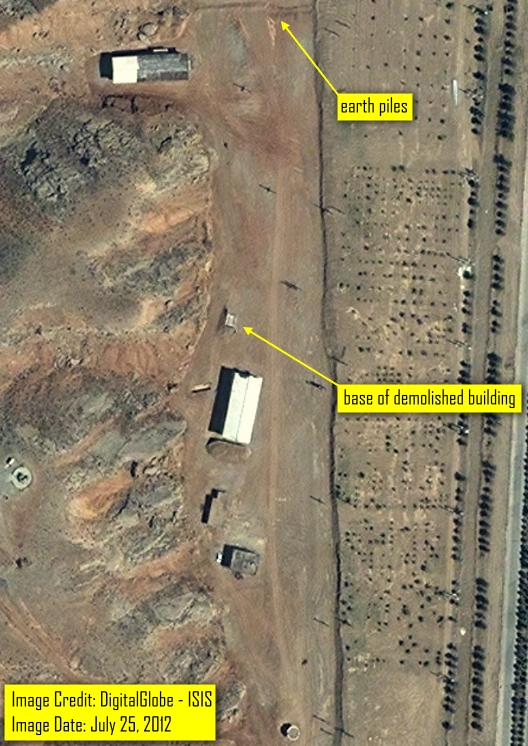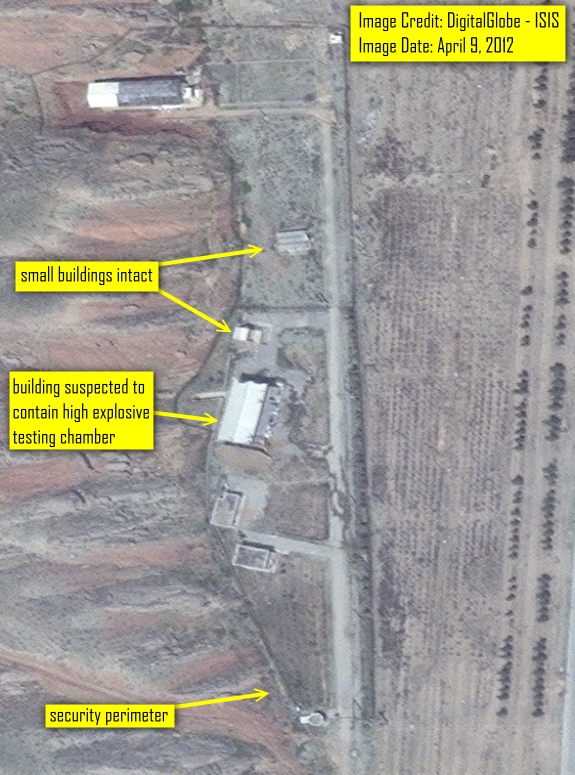Reports
Cleanup Activity at Suspected Parchin Test Site Appears Complete: Site Considerably Altered
by David Albright and Robert Avagyan
August 1, 2012
Commercial satellite imagery from July 25, 2012 of a site at the Parchin military complex shows what appears to be the final result of considerable sanitization and earth displacement activity (see figure 1). The International Atomic Energy Agency (IAEA) suspects that this complex contains a high explosive testing chamber that was used for nuclear weapons related development.
The Parchin site garnered international attention in late February 2012 when the IAEA declared its interest in inspecting it in compliance with its mandate to ensure that there had been no military nuclear related activity. The IAEA wants to inspect the site in particular to ensure that Iran’s declaration under its safeguards agreement is complete. Iran has consistently refused to grant the IAEA access to Parchin. It has insisted instead on allowing access only after the negotiation of a broader agreement addressing all issues concerning the military dimensions of its nuclear program. The IAEA agreed and attempted to negotiate an agreement. However, Iran demanded that the IAEA unduly limit its inspection rights and methods, something it is not prepared to do in any case. Looking back, Iran’s negotiating strategy appeared aimed at stalling while it undertook a range of cleanup activities at the Parchin site.
The site in question had remained unchanged since early 2004 until a month following the IAEA request for access; then what appeared to be clean-up activity began. Iran denied doing any cleanup, calling it routine construction work. The first signs of such activity were publicly reported by ISIS in May 2012 with satellite imagery from April 9, 2012 showing objects lined up outside the suspected high explosive building, and next to it, traces of water flow (figure 2). Over the subsequent four months there was considerable activity with the razing of two buildings within the site, notable earth removal and displacement, the likely cleanup of the inside of the suspect building and possibly its exterior surfaces, the removal of the security perimeter, and the removal of all roadways (reports documenting the changes are available on the ISIS website here).
The latest image from July 25, 2012 shows stark differences in the site’s current layout from earlier imagery in figure 2. The entire area surrounding the buildings appears to have been bulldozed, covered, and flattened. The only remaining traces of activity are the apparent base of one of the demolished buildings and earth piles formed as a result of earth removal and displacement (figure 1). There are no traces of heavy machinery or construction materials suggesting that no major activity is planned in the near future.
The degree of the site’s modification and the fact that this apparent cleanup work started soon after the IAEA’s request for access cast further doubt on Iran’s claims that its nuclear program does not or has never had any military aspects. Notwithstanding its refusal to address the IAEA’s broad evidence and many questions about the possible past military dimensions of its nuclear program, Iran’s refusal to allow prompt access to the Parchin high explosive test site and the subsequent alterations bring into question its intention to clear up its nuclear case with the international community.
The IAEA may be unable to make any further progress in addressing the issues concerning the military dimensions of Iran’s nuclear program. As a result, unless Iran’s demonstrates concretely that it is willing to address these issues by the September IAEA Board of Governors meeting, the Board should pass a resolution that refers this set of issues to the U.N. Security Council for further action, including the imposition of additional sanctions.



 twitter
twitter